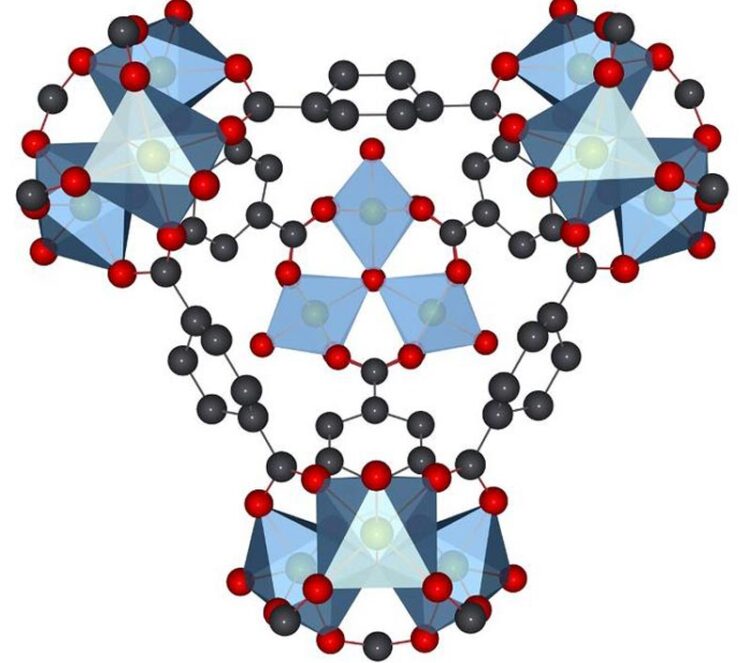Puffed-up MOFs for improved drug delivery

Increasing the pore size of this chromium-containing MOF improved its ability to carry and deliver two common drugs: ibuprofen and 5-fluorouracil.
Credit: Fateme Rezaei
The spongelike structure of metal organic frameworks (MOFs) allows these polymers to possibly carry and deliver a range of therapeutic compounds. Now, researchers reporting in ACS Applied Bio Materials treated a chromium-containing MOF with a dose of acetic acid, more concentrated than in vinegar, to expand its pore size and surface area. The puffed-up MOFs held more ibuprofen or chemotherapy drug compared to the original version and had improved performance as a potential drug-delivery vehicle.
Taking medications by mouth is a convenient way to administer pharmaceuticals. However, this method sometimes involves ingesting several pills per day, or requires large pills that can be difficult to swallow. So, researchers are investigating how to use MOFs for drug delivery to minimize dosing frequency and maximize treatment efficiency. By customizing the polymers’ pore sizes and structures, scientists have created nanoscale vehicles that may offer more controlled and targeted drug release. However, to carry and deliver even more drug molecules, the pores would need to expand further than current versions can. A research team led by Fateme Rezaei at the University of Miami wanted to optimize an existing MOF and improve the polymer’s delivery of two common therapeutics of different molecular sizes: the anti-inflammatory drug ibuprofen and a smaller compound 5-fluorouracil, a chemotherapy drug used to treat cancer.
They started with an established method to synthesize a biocompatible chromium-containing MOF and added a step with an acetic acid rinse. The acid caused the polymer’s pores to expand from about 2.5 nanometers (nm) to 5 nm wide. In laboratory experiments to characterize the MOF’s drug-loading capability, the researchers observed that the puffed-up version took in more ibuprofen and 5-fluorouracil molecules than the chromium-containing framework with standard-sized pores. Then, in drug-delivery experiments, they loaded the pore-expanded and standard MOFs with either ibuprofen or 5-flurouracil and measured how quickly the drugs passed into a saline solution. Rezaei and colleagues found that the new frameworks released both drugs substantially faster than the original ones. The researchers attributed the higher drug loading and release rates to the larger pores and surface area of the expanded framework, which provides larger “doors” for the drug molecules to enter and exit through.
Simple changes such as these could maximize the effectiveness of MOFs in future drug-delivery applications, the researchers say. As a next step, they plan to determine how slow and progressive drug release within specified time frames can be achieved by modifying MOF pore structure.
The authors acknowledge funding from the U.S. National Science Foundation.
The American Chemical Society (ACS) is a nonprofit organization chartered by the U.S. Congress. ACS’ mission is to advance the broader chemistry enterprise and its practitioners for the benefit of Earth and all its people. The Society is a global leader in promoting excellence in science education and providing access to chemistry-related information and research through its multiple research solutions, peer-reviewed journals, scientific conferences, eBooks and weekly news periodical Chemical & Engineering News. ACS journals are among the most cited, most trusted and most read within the scientific literature; however, ACS itself does not conduct chemical research. As a leader in scientific information solutions, its CAS division partners with global innovators to accelerate breakthroughs by curating, connecting and analyzing the world’s scientific knowledge. ACS’ main offices are in Washington, D.C., and Columbus, Ohio.
To automatically receive news releases from the American Chemical Society, contact newsroom@acs.org.
Note: ACS does not conduct research, but publishes and publicizes peer-reviewed scientific studies.
Journal: ACS Applied Bio Materials
DOI: 10.1021/acsabm.3c01007
Article Title: “Performance of MIL-101(Cr) and MIL-101(Cr)-Pore Expanded as Drug Carriers for Ibuprofen and 5‑Fluorouracil Delivery”
Article Publication Date: 8-Jan-2024
Media Contacts
Emily Abbott
American Chemical Society
e_abbott@acs.org
ACS Newsroom
American Chemical Society
newsroom@acs.org
All latest news from the category: Life Sciences and Chemistry
Articles and reports from the Life Sciences and chemistry area deal with applied and basic research into modern biology, chemistry and human medicine.
Valuable information can be found on a range of life sciences fields including bacteriology, biochemistry, bionics, bioinformatics, biophysics, biotechnology, genetics, geobotany, human biology, marine biology, microbiology, molecular biology, cellular biology, zoology, bioinorganic chemistry, microchemistry and environmental chemistry.
Newest articles

Innovative 3D printed scaffolds offer new hope for bone healing
Researchers at the Institute for Bioengineering of Catalonia have developed novel 3D printed PLA-CaP scaffolds that promote blood vessel formation, ensuring better healing and regeneration of bone tissue. Bone is…

The surprising role of gut infection in Alzheimer’s disease
ASU- and Banner Alzheimer’s Institute-led study implicates link between a common virus and the disease, which travels from the gut to the brain and may be a target for antiviral…

Molecular gardening: New enzymes discovered for protein modification pruning
How deubiquitinases USP53 and USP54 cleave long polyubiquitin chains and how the former is linked to liver disease in children. Deubiquitinases (DUBs) are enzymes used by cells to trim protein…



